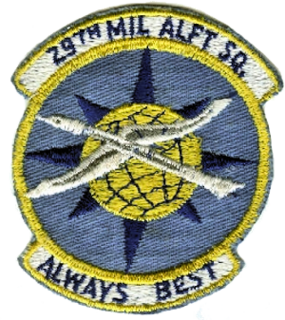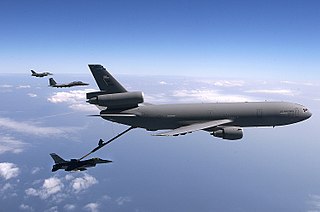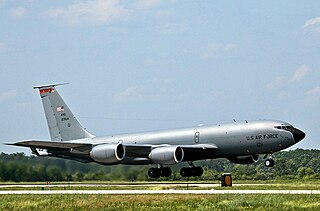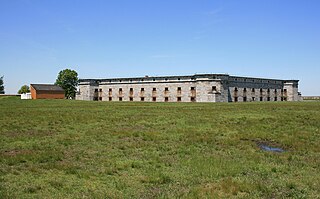 W
WThe 2nd Air Refueling Squadron, sometimes written as 2d Air Refueling Squadron, is a unit of the United States Air Force. It is part of the 305th Air Mobility Wing at Joint Base McGuire-Dix-Lakehurst, New Jersey. The 2nd Air Refueling Squadron is the second-oldest squadron in the Air Force, having over 100 years of service to the nation. Deployed to the Philippines after World War I, during the 1941-1942 Battle of the Philippines, it was wiped out, with the Japanese forcing some of the personnel to endure the Bataan Death March. It was re-formed as an air refueling squadron by Strategic Air Command in 1949. Today, it operates the KC-10 Extender aircraft, conducting aerial refueling missions.
 W
WThe 6th Airlift Squadron is part of the 305th Air Mobility Wing at Joint Base McGuire-Dix-Lakehurst, New Jersey. It operates the Boeing C-17 Globemaster III supporting the United States Air Force global reach mission worldwide. The main base, along with the flying squadron, is located near the borough of Wrightstown, New Jersey.
 W
WThe 7th Air Defense Artillery Regiment is an air defense artillery regiment of the United States Army, first constituted in the Regular Army as the 7th Regiment of Artillery on 8 March 1898. The 6th and 7th U.S. Artillery Regiments were constituted on 8 March 1898, three weeks after the explosion of USS Maine in Havana, Cuba on 15 February 1898, as the United States' declaration of war on Spain and commencement of the Spanish–American War seemed imminent.
 W
WThe 18th Airlift Squadron is an inactive United States Air Force unit. Its last assignment was to the 305th Operations Group, Air Mobility Command, stationed at McGuire Air Force Base, New Jersey.
 W
WThe 29th Military Airlift Squadron is an inactive United States Air Force unit. Its last was assigned to the 438th Military Airlift Wing, Military Airlift Command, stationed at McGuire Air Force Base, New Jersey. It was inactivated on 31 August 1968.
 W
WThe 32nd Air Refueling Squadron, sometimes written as 32d Air Refueling Squadron, is part of the 305th Air Mobility Wing at Joint Base McGuire-Dix-Lakehurst, New Jersey. It operates the KC-10 Extender aircraft conducting air refueling missions. The squadron is one of the oldest in the United States Air Force, its origins dating to 19 May 1917, being organized at Kelly Field, Texas. The squadron deployed to England as part of the American Expeditionary Force during World War I. During World War II, the squadron saw combat service as a B-17 Flying Fortress unit, assigned to the Fifteenth Air Force in Italy. During the early years of the Cold War, it was an RB-47 Stratojet Strategic Reconnaissance Squadron as part of Strategic Air Command (SAC).
 W
WThe 38th Air Transport Squadron is an inactive United States Air Force unit. Its last was assigned to the 1611th Air Transport Wing, Military Air Transport Service, stationed at McGuire Air Force Base, New Jersey. It was inactivated on 25 June 1965.
 W
WThe 40th Military Airlift Squadron is an inactive United States Air Force unit. Its last assignment was to the 438th Military Airlift Wing, Military Airlift Command, stationed at McGuire Air Force Base, New Jersey.
 W
WThe 76th Air Refueling Squadron is part of the 514th Air Mobility Wing at McGuire Air Force Base, New Jersey. It operates the McDonnell Douglas KC-10 Extender aircraft conducting air refueling missions as a reserve associate unit of the 305th Air Mobility Wing.
 W
WThe 78th Air Refueling Squadron is part of the 514th Air Mobility Wing at McGuire Air Force Base, New Jersey. It operates the KC-10 Extender aircraft conducting aerial refueling missions as a reserve associate of the 305th Air Mobility Wing.
 W
WThe 87th Air Base Wing is the host wing at Joint Base McGuire-Dix-Lakehurst, New Jersey and its headquarters are on the McGuire Air Force Base portion of the Joint Base. The wing provides installation support to commands at McGuire Air Force Base, Fort Dix, and Naval Air Engineering Station Lakehurst. Joint Base McGuire-Dix-Lakehurst is the Department of Defense's (DoD) only tri-service joint base that consolidated Air Force, Army, and Navy installations.
 W
WThe 108th Operations Group is a unit of the 108th Wing of the New Jersey Air National Guard, one of the many units stationed at Joint Base McGuire-Dix-Lakehurst, New Jersey. If activated to federal service with the U.S. Air Force, the group is gained by Air Mobility Command (AMC).
 W
WThe 108th Wing is a unit of the New Jersey Air National Guard, one of the many units stationed at Joint Base McGuire-Dix-Lakehurst, New Jersey. If activated to federal service, the Wing is gained by the United States Air Force Air Mobility Command.
 W
WThe 119th Fighter Squadron is a unit of the New Jersey Air National Guard 177th Fighter Wing located at Atlantic City Air National Guard Base, New Jersey. The 119th is equipped with the F-16 Fighting Falcon aircraft.
 W
WThe 141st Air Refueling Squadron is a unit of the New Jersey Air National Guard 108th Wing located at McGuire Air Force Base, New Jersey. The 141st is equipped with the KC-135R Stratotanker.
 W
WThe 150th Air Refueling Squadron was a unit of the New Jersey Air National Guard 108th Air Refueling Wing. It was assigned to McGuire Air Force Base, New Jersey and was equipped with the KC-135 Stratotanker aircraft. The squadron was inactivated in 2008 following the retirement of the wing's KC-135E aircraft.
 W
WThe 170th Group is a unit of the Nebraska Air National Guard, stationed at Offutt Air Force Base, Nebraska. If activated to federal service, the group would be gained by the United States Air Force Air Combat Command.
 W
WThe 177th Fighter Wing is a unit of the New Jersey Air National Guard, stationed at Atlantic City Air National Guard Base, New Jersey. If activated to federal service, the Wing is gained by the United States Air Force Air Combat Command.
 W
WThe 245th Coast Artillery Regiment was a Coast Artillery Corps regiment in the New York National Guard. It garrisoned the Harbor Defenses of New York, New York and predecessor commands 1924–1944.
 W
WThe 302nd Cavalry Regiment was a cavalry unit of the United States Army during World War I, the interwar period, and the Cold War. It was activated in early 1918 but broken up in the middle of the year to form new artillery units. The unit was recreated as a New Jersey Organized Reserve unit during the interwar period, and was converted into a tank destroyer battalion after the United States entered World War II. Reactivated in 1971 and 1973 in the Army Reserve, it was represented by two squadrons in the 100th Division (Training).
 W
WThe 305th Air Mobility Wing is a United States Air Force strategic airlift and air refueling wing under the operational control of the Air Mobility Command. It generates, mobilizes and deploys C-17 Globemaster III and KC-10 Extender aircraft. The 305th AMW is a tenant unit at Joint Base McGuire-Dix-Lakehurst in central New Jersey. It also controls one of the Air Force's busiest aerial ports, and the air operations at both McGuire Air Force Base and Naval Support Activity Lakehurst.
 W
WThe 486th Fighter Squadron is an inactive United States Air Force unit. It was last assigned to the 352d Fighter Group of IX Fighter Command at Camp Kilmer, New Jersey where it was inactivated on 9 November 1945.
 W
WThe 514th Air Mobility Wing is a wing of the United States Air Force based at Joint Base McGuire-Dix-Lakehurst, New Jersey. The 514th is an associate Air Force reserve unit. The wing flies aircraft assigned to the active-duty 305th Air Mobility Wing, also based at McGuire. The 514th shares the responsibility of maintaining and flying the McDonnell Douglas KC-10 Extender and the McDonnell Douglas C-17 Globemaster III.
 W
WThe 599th Bombardment Squadron is an inactive United States Air Force unit. It was activated at MacDill Field, Florida in April 1943. After training in the United States, it transferred to the European Theater of Operations, where it was a component of IX Bomber Command. The squadron served in combat from April 1944 until the end of World War II, earning a Distinguished Unit Citation for an attack on Ediger-Eller, Germany in December 1944 during the Battle of the Bulge. Following V-E Day the squadron remained in France until December 1945, when it returned to the United States and was inactivated at Camp Kilmer in December 1945.
 W
WThe 621st Contingency Response Wing is the sole contingency response wing of the United States Air Force, based out of Joint Base McGuire-Dix-Lakehurst, New Jersey.
 W
WThe 732nd Airlift Squadron, sometimes written as 732d Airlift Squadron, is a unit of the United States Air Force. It was first constituted as the 332nd Bombardment Squadron in 1942, and engaged in strategic bombardment operations in Occupied Europe and Germany during WWII. In 1952, the unit was redesignated the 332nd Tactical Reconnaissance Squadron, and in 1957 the 732nd Troop Carrier Squadron. In 1957, it was redesignated the 732nd Military Airlift Squadron (Associate), before it was finally redesignated as the 732nd Airlift Squadron in 1994. The unit is part of the 514th Air Mobility Wing at McGuire Air Force Base, New Jersey. It operates McDonnell Douglas C-17 Globemaster III aircraft in providing global strategic airlift to US and allied forces.
 W
WThe 1611th Air Transport Wing is an inactive United States Air Force unit. Its last was assigned to the Eastern Transport Air Force, Military Air Transport Service, stationed at McGuire Air Force Base, New Jersey. It was inactivated on 8 January 1966.
 W
WThe 4709th Air Defense Wing is a discontinued United States Air Force organization. Its last assignment was with the 26th Air Division of Air Defense Command (ADC) at McGuire Air Force Base, New Jersey, where it was discontinued in 1956. It was established in 1952 at McGuire as the 4709th Defense Wing in a general reorganization of Air Defense Command (ADC), which replaced wings responsible for a base with wings responsible for a geographical area. It assumed control of several fighter Interceptor squadrons that had been assigned to the 52d Fighter-Interceptor Wing, some of which were Air National Guard squadrons mobilized for the Korean War. It also assumed host responsibility for McGuire through its subordinate 568th Air Base Group.
 W
WThe 4730th Air Defense Group is a discontinued United States Air Force organization. Its last assignment was with the New York Air Defense Sector at McGuire Air Force Base, New Jersey, where it was discontinued in 1959.
 W
WThe 341st Fighter Squadron is an inactive United States Air Force unit. It was last assigned to the 348th Fighter Group, based at Itami Air Base, Japan. It was inactivated on May 10, 1946.
 W
WThe Harbor Defenses of New York was a United States Army Coast Artillery Corps harbor defense command. It coordinated the coast defenses of New York City from 1895 to 1950, beginning with the Endicott program, some of which were located in New Jersey. These included both coast artillery forts and underwater minefields. The command originated circa 1895 as an Artillery District(s) and became the Coast Defenses of Eastern New York and Coast Defenses of Southern New York in 1913. Circa 1915 the Coast Defenses of Sandy Hook separated from the latter command. In 1925 the commands were renamed as Harbor Defense Commands, and in 1935 the Harbor Defenses of Eastern New York was almost entirely disarmed, although possibly retaining the minefield capability. The New York and Sandy Hook commands and the Harbor Defenses of Long Island Sound were unified as the Harbor Defenses of New York on 9 May 1942.
 W
WThe Harbor Defenses of the Delaware was a United States Army Coast Artillery Corps harbor defense command. It coordinated the coast defenses of the Delaware River estuary from 1897 to 1950, beginning with the Endicott program. These included both coast artillery forts and underwater minefields. The areas protected included the cities of Philadelphia, Camden, and Wilmington along with the Chesapeake & Delaware Canal. The command originated circa 1896 as an Artillery District and became the Coast Defenses of the Delaware in 1913, with defenses initially at and near Fort Delaware on Pea Patch Island near Delaware City. In 1925 the command was renamed as a Harbor Defense Command. During World War II the defenses were relocated to Fort Miles on Cape Henlopen at the mouth of the Delaware Bay.